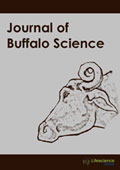jbs
Abstract : Population Diversity and Role in the Socioeconomic Development of Domestic Buffaloes of Rural Areas of District Haripur, KPK Pakistan
|
|
Abstract: This study conducted as a type of survey in a time period duration of 6 month that starts from the end of the march to the end of September total of the 1000 houses were visited from each of the selected villages of Haripur Pakistan along with 100 dairy farms study carried out by the questionnaires and by the direct meeting with the keepers of buffalos. Four villages were selected where the highest population of buffaloes were found in Syria maira. The farm buffalos were kept mostly for the purpose of selling the milk Results showed that the most of the areas the buffalo keeping is for the purpose of selling the milk wile in other where the selling rate is not found they keep them for their own food and milk purposes. It facilitate their economic status to rise as a part time job. Government should take steps to rise there stander. Keywords: Household cattle’s, economic importance, diversity, Remote areas. |
Abstract : Behaviour and Welfare of Dairy Buffaloes: Pasture or Confinement?
|
|
Abstract: This review seeks to integrate recent scientific findings on the behaviour of buffalo cows in different production systems. These issues are discussed in relation to the level of welfare that buffalo cows experience under different production systems. In extensive conditions, the level of welfare is high because the animals are free to express natural behaviours related to feeding (grazing, ruminating) and rest. In contrast, intensified livestock-raising methods and techniques (machine-milking, artificial breeding etc.), first developed for dairy cattle are increasingly being used with water buffaloes in order to increase milk production. Greater knowledge of the biology of dairy buffaloes in aspects linked to physiology, behaviour, and health, together with needed adjustments to their production systems, will indicate options for improving the levels of comfort and welfare of these animals and contribute to increasing the efficiency of this type of dairy production. It is necessary to appreciate the importance of welfare within the entire chain of animal production since each of the scientific aspects considered in this manuscript reflects that animal welfare is not an absolute term, but multidisciplinary, with direct consequences on productivity. The welfare of animals in the production systems must be considered with the aim of ensuring an adequate nutritional, clinical, sanitary and behavioural status of the animals. When these aspects are achieved, production can be maximized and, for this reason, it is essential to maintain a balance between welfare and productivity. Keywords: Buffaloes, behaviour, welfare, extensive system, intensive system. |
Abstract : Imprinting, Sucking and Allosucking Behaviors in Buffalo Calves
|
|
Abstract: This paper provides a short review of the scientific literature, focusing on recent advances on the most representative events from birth to weaning, with special emphasis on the behavior and welfare of buffalo calves during the phases of imprinting, suckling and allosucking, based on the differences and similarities reported with dairy and beef cattle. The similarities include the facts that all 3 are gregarious animals whose dams separate from the herd prior to parturition to facilitate dam-calf bonding, and that maternal care fosters the ingestion of colostrum by the young. These species are also precocial and rely on mother – young mutual recognition for calf survival. In particular, mothers develop a selective bonding with their young soon after parturition, although buffalo cows seem to be tolerant to alien claves and are often engaged in communal nursing. In buffaloes and cattle negative emotions are induced by the stress brought on by early maternal separation. However, buffalo calves are more prone to express cross-sucking and contract neonatal diseases with higher mortality rates in intensive systems as compared to cattle. The review concludes that all three exhibit similar behaviors from parturition to weaning although the knowledge about the specific needs of buffalo calves should be increased and appropriate management practices implemented to improve their welfare state. Keywords: Cow-calf bonding, calving, dam-calf bonding, buffalo calves, dairy calves, beef cattle calves, welfare, suckling behaviour, allosuckling. |
Abstract : Life Cycle Assessment of Dairy Buffalo Calves in an Italian Farm
|
|
Abstract: The aim of this paper was to examine the environmental consequences of raising buffalo calves, as assessed by life cycle assessment. Life cycle assessment has been widely used to assess the environmental impact of different livestock production systems. The primary data were collected from 32 animals aged 0-90 days. Calves were allowed to uptake colostrum before separation from their mothers within 24-h after birth. After separation, the animals were kept individually (1 x 2 m) for 8 weeks and then housed in groups of 8 in straw-bedded pens (5 x 8 m). According to the results of the analysis, the contributions from all calves to global warming potential, acidification potential, eutrophication potential, non-renewable energy use was high. In particular, the impact generated from global warm potential was 7 kg CO2 – eq per day, and the impact of non-renewable energy use was 38 MJ – eq per day. Our results estimated for the first time the environmental impact generated from buffalo calves. We conclude that the strategies to mitigate the effects on the environment impact must start from the birth of the buffalo calves and then continue throughout its life cycle. Keywords: Life cycle assessment, buffalo calf, global warming potential, environmental sustainability, dairy farming. |






















